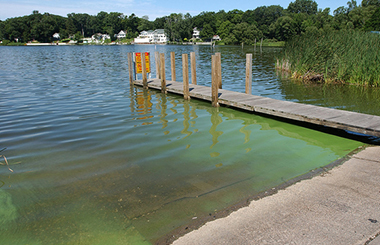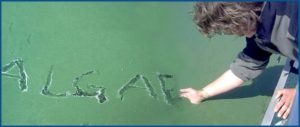After nearly six years of relatively clear, algae-free waters, harmful algae blooms (HABs) were recently detected in Ford and Belleville Lakes. While these blooms were not extensive, if it happens again, they should be avoided by any people or pets going into those waters. Ford and Belleville Lakes are impounded reservoirs formed by dams on the Huron River.

What are Harmful Algal Blooms (HABs)
Harmful algal blooms are overgrowths of algae or bacteria in water. Some, like blue-green algae or cyanobacteria produce dangerous toxins in water, but even nontoxic blooms impact aquatic wildlife and recreation. A confirmed HAB can release toxins like microcystin that can cause significant gastrointestinal problems and, in some rare cases, even death in pets and humans. If the blooms are large enough, HABs can also create dead zones (areas of water with no oxygen) and lead to fish die-offs. Lake Erie suffers from a sizable dead zone periodically.
In the case of Ford and Belleville Lakes, the Department of Environmental Quality (DEQ) investigated several thick algae mats in mid-September to determine their microcystin content. They found multiple locations in each lake with microcystin levels above health standards for safety. The county and local municipalities issued an advisory to avoid contact with the water in several locations. Most of the detection locations were downstream (to the east) in the lakes, and along the southern shores, with an exception being a bay of Ford Lake bordering the “Cliffs on the Bay” residential development. The DEQ removed the advisory on October 4, 2018, once microcystin levels dropped below health safety standards.
HABs occur in lakes across our region
Unfortunately, these HABs are not unusual in Southeast Michigan lakes. Microcystin was detected in Brighton and Ore Lakes last summer at low levels, though the bloom was extensive. HRWC conducted sediment surveys for those lakes (see newsletter article) and found that phosphorus coming from existing lake sediment may be the major cause. Microcystin has also has been detected in several other lakes (Pontiac and Sugden Lakes, for example) in the watershed, and many others across southern Michigan. The Ford and Belleville Lake blooms are unusual due to their late appearance in the year. Algae blooms can occur in lakes with excessive nutrients (like phosphorus) under conditions that include warm temperature, light to no wind, and days to weeks of little to no rain.
HABs in Ford and Belleville Lakes are uncommon

A recent history of good lake management makes these recent blooms in Ford and Belleville Lakes unusual. Municipal governments around and upstream of the lakes have worked since 1995 to understand and reduce the amount of nutrients getting into the system. They have made tremendous progress. Phosphorus inputs have been reduced 25-40% since these local partners began working on it, and are almost at state-mandated targets.
Additionally, Ypsilanti Township has managed the flow of water at the Ford Lake dam to help control for phosphorus coming off of sediments at the bottom of the lake. To do this, the Township releases water from the bottom of the dam when dissolved oxygen levels in the lake approach zero. That mixes the bottom water and keeps it oxygenated. This good management has reduced the frequency of algae blooms–there has not been a significant bloom reported since 2012…until this September.
The problem this year is that the flow level was too low to keep the dam turbines running AND send enough water through the bottom gates to mix the lake. Ford Lake went anoxic at its deepest levels for a period of time, releasing large amounts of phosphorus from legacy sediment, and this likely led to the HABs in Ford Lake, and then downstream in Belleville Lake.
HRWC continues to work with the Middle Huron Partners and other partner groups in Livingston County and Wayne County to improve management of stormwater and nutrient runoff to prevent or reduce the frequency of HABs. HRWC also works with Michigan DEQ, county health departments and lake associations to inform the public when they do occur.



